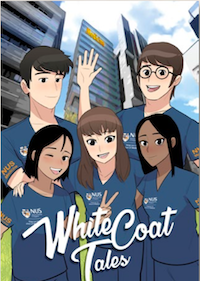What is it like being a medical student in Singapore? There is no better way to find out than in White Coat Tales, a graphic novel that follows the journeys of five medical students attending the NUS Yong Loo Lin School of Medicine (NUS Medicine). These stories capture their journey through medical school, portraying their ups and downs painstakingly yet authentically.
Before the COVID-19 disruption, NUS Medicine had a long tradition where freshmen underwent a rite of passage lasting several days, starting with a meet-and-greet session, followed by a welcome dinner where males wear the Class Tie and females wear the Class Scarf they are given. During the dinner, their respective House Masters hand a candle to the students (each student is sorted into one of ten Houses). "Wow, a candle, a bit much, don't you think?" says one of the students in the novel. The candle "symbolises the sharing of knowledge from master mentors to the students, and is a reminder to remain hopeful when the going gets tough."
Another preface to university life is the orientation activities, where the five students participate in several student-organised events such as Rag and Flag and MediCamp. This culminates in a RAG (Receive and Give) Day competition where the students put up a colourful, vibrant performance competing between the different faculties, and to their delight, they win. This is followed by the highlight, the White Coat Ceremony, which echoes the title of the book. Faculty members help the students don their very first white coats, serving as a reminder of their solemn responsibilities and roles as doctors in training, which the professor pronounces "is an acknowledgement of your commitment to be a doctor and... it is a solemn promise that you will uphold the integrity of the medical profession."
Introducing the main characters
First, there is Samantha whose family runs a hawker stall. She scored badly for her GCE O Levels and was shunted to the less academic institutions. Fortunately, she found herself and got into medical school, where her warm personality and good looks captured the attention of her classmates. Second, there is Paul who was undecided on whether to study medicine or the arts, spending two years backpacking around the world before enrolling into medical school. He is attracted to Samantha.
Third, there is Shafia, who buried herself inside books, and ensconced herself in the halls of residence without going back home for long stretches. Her parents frequently sent her text messages but she kept on giving the excuse that she was busy studying, only realising her selfishness when one of her patients complained that none of his children visited him in hospital.
Then, there is Yao Quan who came from a line of doctors. He started off being a frequent partygoer, having a lackadaisical attitude towards medicine coupled with a rather arrogant, insufferable personality. But following a mistake he made when inserting an intravenous drip, causing pain to his patient, he became remorseful and changed to become a kinder and more empathetic person. Finally, there is Divya, an overachiever who frequently stayed up late studying, and always aced her examinations. Her mentor professor persuaded her to be more holistic by volunteering for community service in a poor overseas village. Eventually Divya graduated and was selected to be the class valedictorian, the highest honour for a graduating student.
A good reminder
Most doctors reading this book may recognise some of these characters, and they may even have been through similar experiences. By following the lives of these five students, we gain a deeper understanding of their hardships, frustrations and tragedies, as well as their triumphs. Becoming a doctor is about developing compassion, thinking of others before oneself and building a never-say-die attitude to battle the challenges they will face. The book is emotionally charged, and what is really surprising is the power of the graphic novel in moving us.
White Coat Tales scores several firsts. It is the first graphic novel in the world to depict the lives of medical students and document medical school traditions. It is a pioneer in embedding a QR code within the pages to link the contents to online video scenes and references, guiding readers in their understanding of aspects of teaching, learning and school life. There is also a link included for students looking for financial help. The polished drawings and carefully captured speech bubbles make for a most enjoyable reading.
Both of us were brought up on comics, and for many of us who suffer from dyslexia, graphic novels are our preferred form of literature. Students wanting to learn more about medical school and how to become a good doctor should read this book. It prepares current undergraduates to anticipate problems, but also tells them not to miss out on building friendships and to seize the many opportunities that medical school accords them. It accurately depicts the events and journeys of medical students in NUS Medicine. For practising doctors, it is a good reminder of why we chose to take up the mantle of our profession. We highly recommend this book to everyone.
Creative teams
It took more than a few creative minds in NUS Medicine to conceptualise, ideate and put an arresting storyline to pen and graphics:
NUS Medicine team
Prof Chong Yap Seng, Dean
Dr Tam Wai Jia, Deputy Lead, Global Health and Community Service
Dr Toh Ying Pin Ann, Adjunct Clinician Educator
Emma Goh, Senior Manager, Communications
Amanda Jane Yap, Senior Executive, Dean's Office

Title: White Coat Tales
Authors: Suffian Hakim and NUS Medicine Team
Illustrator: Eugene Lim
Number of pages: 200
ISBN: 9789814901598
Type of book: Paperback
Publisher: Epigram Books
Year of publication: 2021
Available at: Epigram Books online bookshop, Kinokuniya and Times bookstores
Further readings
- Chin JJ. The White Coat. SMA News 2013; 45(8): 10-2.
- NUS Yong Loo Lin School of Medicine. White Coat Ceremony 2016. Available at: https://nus.edu/3CqIdby.